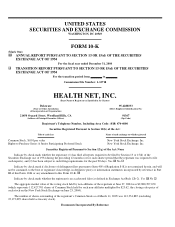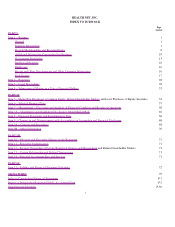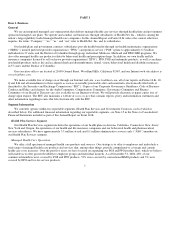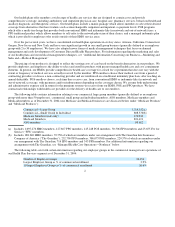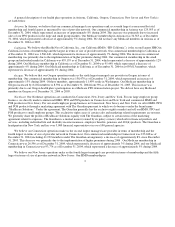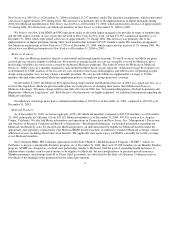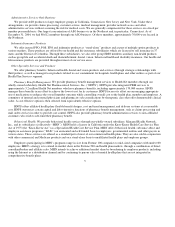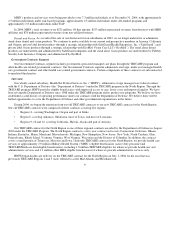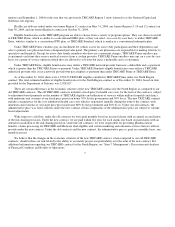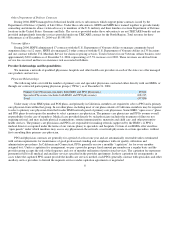Health Net 2004 Annual Report Download - page 5
Download and view the complete annual report
Please find page 5 of the 2004 Health Net annual report below. You can navigate through the pages in the report by either clicking on the pages listed below, or by using the keyword search tool below to find specific information within the annual report.
Our health plans offer members a wide range of health care services that are designed to contain costs and provide
comprehensive coverage, including ambulatory and outpatient physician care, hospital care, pharmacy services, behavioral health and
ancillary diagnostic and therapeutic services. Our health plans include a matrix package which allows members to select their desired
coverage from alternatives that have features such as interchangeable outpatient and inpatient co-payment levels; POS programs
which offer a multi-tier design that provides both conventional HMO and indemnity-like (in-network and out-of-network) tiers; a
PPO traditional product which allows members to self-refer to the network physician of their choice; and a managed indemnity plan
which is provided for employees who reside outside of their HMO service areas.
Over the past several years, we have consolidated our health plan operations in six key states, Arizona, California, Connecticut,
Oregon, New Jersey and New York and have seen significant growth in our small group business (generally defined as an employer
group with 2 to 50 employees). We have also adopted newer forms of medical management techniques that focus on demand
management and early development of Consumer Directed Health Plan products. For information regarding the marketing and sales
of our health plans and our medical management techniques, see “Additional Information Concerning our Business—Marketing and
Sales and—Medical Management.”
The pricing of our products is designed to reflect the varying costs of care based on the benefit alternatives in our products. We
provide employers and employees the ability to select and enroll in products with greater managed health care and cost containment
elements. In general, our HMOs provide comprehensive health care coverage for a fixed fee or premium that does not vary with the
extent or frequency of medical services actually received by the member. PPO enrollees choose their medical care from a panel of
contracting providers or choose a non-contracting provider and are reimbursed on a traditional indemnity plan basis after reaching an
annual deductible. POS enrollees choose, each time they receive care, from conventional HMO or indemnity-like (in-network and
out-of-network) coverage, with payments and/or reimbursement depending on the coverage chosen. We assume both underwriting
and administrative expense risk in return for the premium revenue we receive from our HMO, POS and PPO products. We have
contractual relationships with health care providers for the delivery of health care to our enrollees.
The following table contains information relating to our commercial large group members (generally defined as an employer
group with more than 50 employees), commercial small group and individual members, ASO members, Medicare members and
Medicaid members as of December 31, 2004 (our Medicare and Medicaid businesses are discussed below under “Medicare Products”
and “Medicaid Products”):
The following table sets forth certain information regarding our employer groups in the commercial managed care operations of
our Health Plan Services segment as of December 31, 2004:
2
Commercial
—
Large Group
1,714,152(a)
Commercial
—
Small Group & Individual
808,370(b)
Medicare Members (risk only)
170,943
Medicaid Members
831,421
ASO members
80,612
(a) Includes 1,097,276 HMO members, 127,667 PPO members, 415,248 POS members, 50,306 EPO members and 23,655 Fee for
Service (“FFS”) members.
(b) Includes 188,240 HMO members, 39,750 of which are members under our arrangement with The Guardian Life Insurance
Company of America (“The Guardian”); 232,796 PPO members; 386,073 POS members, 220,376 of which are members under
our arrangement with The Guardian; 716 EPO members and 545 FFS members. For additional information regarding our
arrangement with The Guardian, see “Managed Health Care Operations
—
Northeast” below.
Number of Employer Groups
36,194
Largest Employer Group as % of commercial enrollment
3.9%
10 largest Employer Groups as % of commercial enrollment
16.6%

